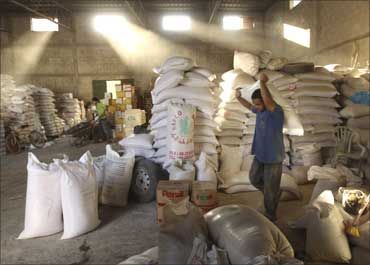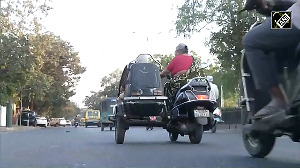For FY16, the subsidy has been estimated at about Rs 8,000 crore (Rs 80 billion).
 The Narendra Modi-led government is aiming big on Aadhaar-based biometric authentication, which it plans to roll out at all fair price shops across the country by end-2016.
The Narendra Modi-led government is aiming big on Aadhaar-based biometric authentication, which it plans to roll out at all fair price shops across the country by end-2016.
It is also looking to use the mechanism to identify beneficiaries of kerosene subsidies, Business Standard has learnt.
The Centre, with help from states, has already rolled out biometric authentication facilities in around 50,000 fair price shops, including 44 in Delhi, to identify beneficiaries of subsidised foodgrains under the public distribution system.
There are about 500,000 fair price shops in all states and Union territories combined.
According to sources, Central and state governments are likely to ramp up the roll-out of biometric authentication devices -- essentially tablets connected to the database with authentication software and printers.
“We are aiming at December 2016 or March 2017 latest to roll out biometric authentication in all of the 500,000 fair price shops,” said a senior official aware of the plans.
The official said the identification of kerosene subsidy beneficiaries will also be under biometric authentication.
However, this will be worked upon only after the Centre and states reach an agreement to share the future subsidy burden and look at ways to reduce kerosene subsidy.
For FY16, the subsidy has been estimated at about Rs 8,000 crore (Rs 80 billion).
Biometric identification of kerosene beneficiaries also means that the beneficiaries’ ration card details will have to be linked to Aadhaar, as the authentication is linked to the unique identification database.
The Supreme Court had mandated in August that Aadhaar could be used for public distribution of foodgrain and kerosene, but it also ruled that it should be voluntary.
The deadline for the states to achieve 100 per cent digitisation of beneficiaries’ details is December 31.
Indications are that it might be extended.
“The states have to ramp up digitisation and linking of beneficiaries’ data; Otherwise, the aim of rolling out biometric authentication nationwide might fall short of our target,” said another official.
According to data available on the website of the ministry of consumer affairs, food and public distribution, while nearly all states have completed digitisation of fair price shops and godown data, 13 states are lagging behind in ration card data.
These include Arunachal Pradesh, Assam, Himachal Pradesh, Jammu & Kashmir, Manipur, Meghalaya, Nagaland, Odisha, Punjab, Rajasthan, Uttar Pradesh, Uttarakhand, and West Bengal.
Only six states have taken the lead in digitising the data of beneficiaries -- Chhattisgarh, Delhi, Gujarat, Karnataka, Andhra Pradesh and Maharashtra. Others have either not started at all, or only implemented in very few blocks and districts.
According to data available on the Unique Identification Authority of India website, as on October 31, the percentage of Aadhaar penetration, compared to a state’s population, was as low as 1.7 per cent.
In Assam and Meghalaya, it was 1.4 per cent.
ARMED FOR THE FUTURE
- Biometric authentication rolled out in about 50,000 fair price shops
- There are about 500,000 fair price shops nationwide
- Plan to roll out biometric identification in all of them by December 2016-March 2017
- Authentication used for food subsidy beneficiaries so far
- Will be used for kerosene as well once Centre, states reach subsidy reduction agreement
The image is used for representational purpose only. Photograph: Reuters










